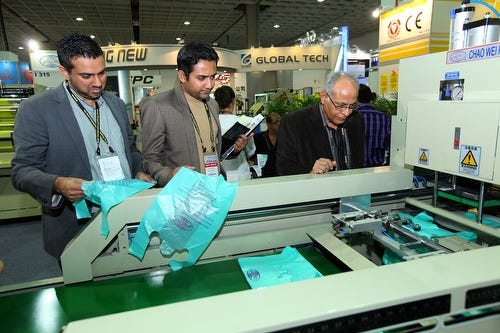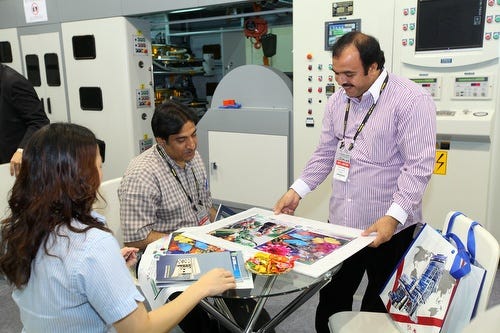Made in Taiwan, but sold elsewhere: Taiwanese plastics machinery explores emerging markets
Taipei, Taiwan - For the first half of this year, Taiwanese rubber and plastic machinery exports declined to a value of $631.7 million, down 2% compared to the previous year.This decline mainly occurred in the BRIC countries (Brazil, Russia, India, and China) while Thailand, Vietnam, Indonesia and Japan showed positive growth, according to representatives at the Taipei International Plastic & Rubber Industry Show 2012 (Sept. 21-25; Nangang Exhibition Hall).
September 28, 2012
Taipei, Taiwan - For the first half of this year, Taiwanese rubber and plastic machinery exports declined to a value of $631.7 million, down 2% compared to the previous year.
This decline mainly occurred in the BRIC countries (Brazil, Russia, India, and China) while Thailand, Vietnam, Indonesia and Japan showed positive growth, according to representatives at the Taipei International Plastic & Rubber Industry Show 2012 (Sept. 21-25; Nangang Exhibition Hall).
 In 2011, the export value of Taiwanese plastic and rubber machinery products grew 14.4% and reached $1.34 billion in 2011.
In 2011, the export value of Taiwanese plastic and rubber machinery products grew 14.4% and reached $1.34 billion in 2011.
"Last year, was a fruitful year for the Taiwan plastic industry, said Hsiu Tsang Hsu, chairman of the Taiwan Association of Machinery Industry (TAMI). "This year is bit trying but the industry remains strong."
At Taipei Plas 2012, David Wu, chairman of the Plastic and Rubber Machinery committee of TAMI, said the impacts of the "sluggish" U.S. economy and European debt crisis were the main reasons for the decline, which resulted in reduced purchases of machinery in emerging markets.
"Rubber and plastic exports from January to June 2012 still maintained its result in comparison to last year, which is a remarkable achievement especially in these difficult times with the worsening of U.S. and Japanese economies and the debt crisis in Europe, which lead to the slow down of developing countries and the BRICs," he said.
TAMI President C.C. Wang noted the deciding factors affecting the export performance of Taiwan's machinery industry in 2012 include unsteady prices of raw materials such as steel and iron, the appreciation of local currency against greenback, and the free trade agreements inked by South Korea and the European Union and between South Korea and the U.S.
Mainland China, Taiwanese largest exporting country, saw a decrease of 7.5% from the previous year.
Still, despite the declining China market, Wu said that the industry can never overlook the country since its the destination of more than 50% of Taiwanese plastic and rubber machinery exports.
Taiwan is the fourth largest exporter of plastics and rubber machinery in the world. Nearly 82% is exported and the main categories include plastic injection molding machines, thermoforming machines and blowmolding machines.
Last year, Taiwan produced about 15,000 plastic injection molding machines while Japan produced about 12,500 but with a unit price 3 to 4 times of Taiwan, Wu said.
"This shows that there is still room for raising our unit price," Wu said. "I believe advances in quality, technology and marketing and the collaboration among the machinery industry, government agencies and academic institutions will improve the quality and quantity of our machinery."
Growth in emerging exporting markets
John Hsu, chairman of TAMI, said while the export value of plastics machinery declined to mainland China, India, and Vietnam, exports grew steadily in other southeast Asian countries such as Thailand, Indonesia, and Malaysia.
"In addition to the continued strengthening of these markets, efforts should be made to help the plastics and rubber machinery industry explore other emerging markets, holding exhibitions and marketing events in countries like Egypt, Saudi Arabia, Bangladesh, Brazil, Mexico, Poland and Russia to get more business," he said.
Kai Mei Plastic Machinery Co. is a manufacturer of blowmolding machines for food, pharmaceutical and the cosmetics packaging industries. Jack Chen, general manager with Kai Mei, told PlasticsToday the company sees exporting opportunities in Africa, Europe, and Iraq.
packaging industries. Jack Chen, general manager with Kai Mei, told PlasticsToday the company sees exporting opportunities in Africa, Europe, and Iraq.
Wu said India continues to serve as another important emerging market for Taiwan, particularly for injection molding machines. Wu compared the overall growth rate in India to that of mainland China about 10 years ago.
He pointed out that India's imposed anti-dumping duty on Chinese plastic machinery puts "us in an advantageous position to expand local market share, which is an opportunity we should seize."
While the Taiwanese can be a bit more cautious in working with India than China because of the different cultures, he still sees opportunity for joint ventures between Taiwanese and Indian companies.
Perrys Chang, sales supervisor for Taiwan-based Worldly Industrial Co., a manufacturer of converting equipment for flexible packaging materials, said that one of the company's main markets for exporting is India and next year the company is targeting Russia and Latin America. Chang said that exports for the company are up this year.
Taiwanese auxiliary equipment maker Shini Plastics Technology also echoed the talk of growth in India. Alan Chen, overseas business and marketing director for Shini, said while the company's biggest market is China (about 30%), they believe their next big market will be in India. The company established Shini India in 2009, which marked its first manufacturing site outside of the China region. Chen said that the U.S. is still a strong market for the company, and that they plan to build a new facility in the states to support that growth.
Bush Hsieh, vice chairman of plastic and rubber machinery committee of TAMI, also said they expect demand from southeastern Asian countries will grow.
Indonesia, for instance, has a stable political environment that has attracted foreign investment, which has driven GDP growth and lower unemployment, he said. The country has enjoyed an economic growth rate of more than 5%.
According to the Asian development bank, Myanmar could expand at 7% to 8% a year by 2030.
Thailand also represents rapid growth due to the demand from factories to replace old machinery after the floods, Hsieh said.
With growing demand in southeast Asia, the total out value in 2012 is expected to increase compared to the previous year, which represents "new opportunity for Taiwanese machinery manufacturers," Hsieh said.
Wu Den-Yih, Vice President of The Republic of China (Taiwan), said while it's difficult to predict the course of the changing economy, in order to survive, one most continue to improve, such as being a more customer oriented society. He also emphasized the importance of the plastics industry to the country's economy, which relates to job opportunities and increased revenue.
"We hope you can export more, sell more so that the government can grow more, but the government also has a responsibility," he said. "I'm here to extend my gratitude to all who build the market for 'Made in Taiwan' products."
About the Author(s)
You May Also Like


